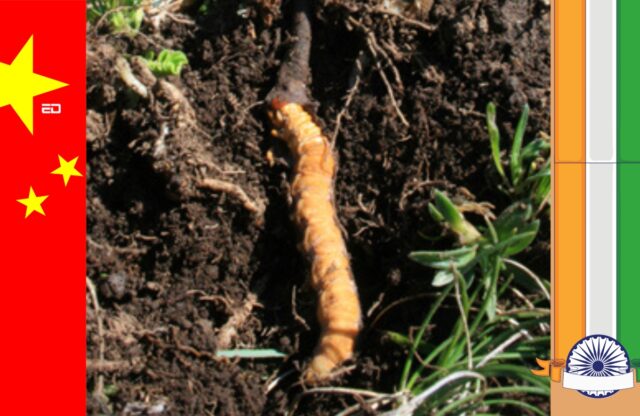There are reports of Chinese intrusion into Indian territory, not for strategic control but for collecting Himalayan gold. Chinese have been accused of illegally entering Arunachal Pradesh to collect this costly herbal drug called Cordyceps.
The report by Indo-Pacific Centre for Strategic Communications has said that multiple attempts were made by the People’s Liberation Army to transgress the borders of Arunachal Pradesh to pick up these expensive fungi. The report was released on 25th December.
What Is Cordyceps?
The fungus Cordyceps is mainly found in the Qinghai-Tibetan plateau in southwestern China and Indian Himalayas. Cordyceps grows on the larvae of the insect.
When the fungi infect the insect, they hijack its body and eventually grow out from its corpse. These fungi are therefore called parasitic fungi. Cordyceps Sinensis grows in the Himalayas and parasitizes the larvae of host moths. It grows from the head of the caterpillar. Hence, the name caterpillar fungus.
Also Read: Here Is Why China Is Praising India, Quite Surprisingly So!
Why Are They So Important?
The emerging Chinese middle class considers this drug to be a remedy for everything ranging from impotence to kidney disorders. Though, this has no scientific evidence. China is also the largest producer and exporter of this fungus.
According to the IPCSC report, the harvest has declined in China in recent years. The increasing demand and the fewer resources have resulted in the over-harvesting of this herbal drug. Times Now explains,’ a small 10-gram bag of Cordyceps can retail for the equivalent of $700 USD. 10 grams of gold is worth about $500.” This shows that cordyceps is more expensive than gold.’
Why Is Indian Territory Being Transgressed?
Cordyceps is very difficult to cultivate commercially as it is mostly harvested from the wild. There have been many unsuccessful attempts at cultivating it in the lab and they are now becoming rare even in the wilds.
According to IPCSC, “Some towns in the Himalayas rely on collecting and selling this fungus for a living. In fact, experts say that up to 80 percent of household income in the Tibetan Plateau and Himalayas can come from selling caterpillar fungus.” Hence, China has turned to Indian Himalayas for getting fungi.
The India-China border in the northeast is a fertile ground for exotic items. Often the locals stray and are detained by soldiers on the other side. The primary question arises- In a country that is scientifically developed, why are they relying on an Indian drug which has no scientific evidence of healing every disease? Is it strategic business or a superstitious rumour?
Image Credits: Google Images
Feature image designed by Saudamini Seth
Sources: Economic Times, The Mint, Times Now
Find the blogger: Katyayani Joshi
This post is tagged under: cordyceps, drug, herb, medicine, Chinese, intrusion, Indian, territory, Arunachal Pradesh, Indian Himalayas, harvest, parasitic fungus, costly, gold, export, Chinese army, People’s Liberation Army, emerging middle class, remedy, disease
Disclaimer: We do not hold any right, or copyright over any of the images used, these have been taken from Google. In case of credits or removal, the owner may kindly mail us.
































[…] To Collect A Fungus Costlier Than Gold Is Reason Behind China’s Illegal Intrusion Into Indian … […]